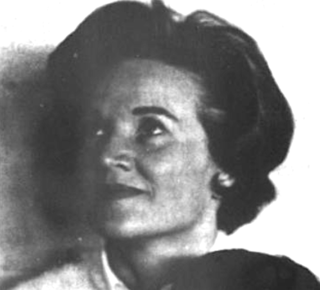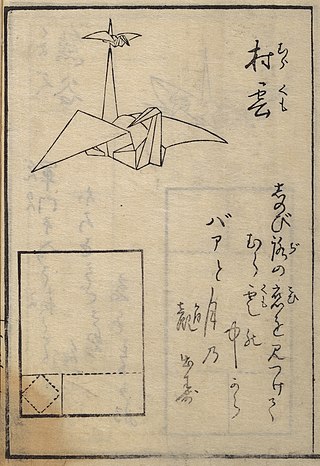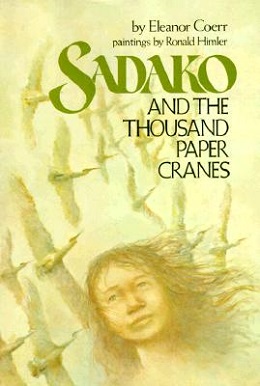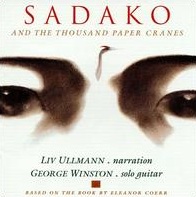
Sadako Sasaki was a Japanese girl who became a victim of the atomic bombings of Hiroshima and Nagasaki by the United States. She was two years of age when the bombs were dropped and was severely irradiated. She survived for another ten years, becoming one of the most widely known hibakusha—a Japanese term meaning "bomb-affected person". She is remembered through the story of the more than one thousand origami cranes she folded before her death. She died at the age of 12 on October 25, 1955 at the Hiroshima Red Cross Hospital.

Peace Park is a park located in the University District of Seattle, Washington, at the corner of N.E. 40th Street and 9th Avenue N.E., at the northern end of the University Bridge. Its construction was conceived and led by Floyd Schmoe, winner of the 1988 Hiroshima Peace Prize, and dedicated on August 6, 1990. 45 years after the atomic bombing of Hiroshima, it is home to a full-size bronze statue of Sadako Sasaki sculpted by Daryl Smith.

Hibakusha is a word of Japanese origin generally designating the people affected by the atomic bombings of Hiroshima and Nagasaki at the end of World War II.
Sadako is a Japanese name, commonly used for women. Sadako is also a film. The same name can be written with a variety of kanji, and the meanings of the name differ accordingly:

Eleanor Coerr was a Canadian-born American writer of children's books, including Sadako and the Thousand Paper Cranes and many picture books.

Hiroshima Peace Memorial Park is a memorial park in the center of Hiroshima, Japan. It is dedicated to the legacy of Hiroshima as the first city in the world to suffer a nuclear attack at the end of World War II, and to the memories of the bomb's direct and indirect victims. The Hiroshima Peace Memorial Park is visited by more than one million people each year. The park is there in memory of the victims of the nuclear attack on August 6, 1945, in which the United States dropped an atomic bomb on the Japanese city of Hiroshima. The Hiroshima Peace Memorial Park was planned and designed by the Japanese Architect Kenzō Tange at Tange Lab.

The history of origami followed after the invention of paper and was a result of paper's use in society. In the detailed Japanese classification, origami is divided into stylized ceremonial origami and recreational origami, and only recreational origami is generally recognized as origami. However, this page describes the history of both ceremonial and recreational origami.

The Hiroshima Peace Memorial Museum is a museum located in Hiroshima Peace Memorial Park, in central Hiroshima, Japan, dedicated to documenting the atomic bombing of Hiroshima in World War II.

The crane is a mystical or holy creature in Japan and is said to live for a thousand years. That is why one thousand origami cranes are made, one for each year. In some stories, it is believed that the cranes must be completed within one year and they must all be made by the person who will make the wish at the end.

The Children's Peace Monument is a monument for peace to commemorate Sadako Sasaki and the thousands of child victims of the atomic bombing of Hiroshima. This monument is located in Hiroshima, Japan. Sadako Sasaki, a young girl, died of leukemia from radiation of the atomic bomb dropped on Hiroshima on 6 August 1945.

Sadako and the Thousand Paper Cranes is a children's historical novel written by Canadian-American author Eleanor Coerr and published in 1977. It is based on the story of Sadako Sasaki.
Karl Bruckner was an Austrian children's writer.
This is a list of cultural products made about the atomic bombings of Hiroshima and Nagasaki. It includes literature, film, music and other art forms.

Sadako and the Thousand Paper Cranes is an album by pianist George Winston with narration by actress Liv Ullmann, released in 1995. Winston's guitar solos also appear apart from the narration, which follows the true story of Sadako Sasaki, a victim of Hiroshima bombing. Suffering from radiation-induced leukemia, Sadako spent her time in a hospital folding origami paper cranes hoping to make a thousand of them and thereby receiving a wish, one she would use to heal and live.

The orizuru, origami crane or paper crane, is a design that is considered to be the most classic of all Japanese origami. In Japanese culture, it is believed that its wings carry souls up to paradise, and it is a representation of the Japanese red-crowned crane, referred to as the "Honourable Lord Crane" in Japanese culture. It is often used as a ceremonial wrapper or restaurant table decoration. A thousand orizuru strung together is called senbazuru (千羽鶴), meaning "thousand cranes", and it is said that if someone folds a thousand cranes, they are granted one wish.

The Peace Crane Project was founded in 2013 by Sue DiCicco, in order to promote world peace and raise awareness of the International Day of Peace.

"An dem Feste", WAB 59a, is a song composed by the 19-year-old Anton Bruckner in 1843 during his stay as schoolteacher's assistant in Kronstorf. In 1893, near the end of his life, Bruckner modified slightly its music score and let Karl Ptak put another text on the song, with as title "Tafellied", WAB 59c.

Herbstkummer, WAB 72 is a lied composed by Anton Bruckner in 1864.
Das Leben geht weiter is a 2002 German documentary film directed by Mark Cairns. It's based on the book by the same name written by Hans-Christoph Blumenberg, the film meticulously reconstructs the last months of the Third Reich.
Masamoto Nasu was a Japanese children's writer.















